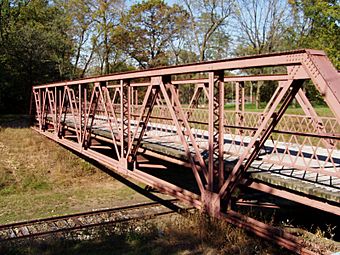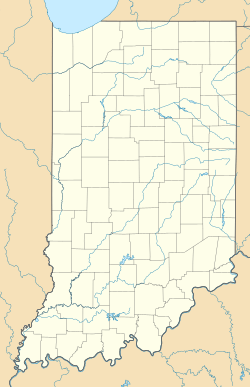Starke County Bridge No. 39 facts for kids
Quick facts for kids |
|
|
Starke County Bridge No. 39
|
|
 |
|
| Location | Jct. of Main and Water Sts., across the former Pennsylvania RR cut, Knox, Indiana |
|---|---|
| Area | less than one acre |
| Built | 1915 |
| Built by | Rochester Bridge Company |
| Architectural style | Warren Pony Truss |
| NRHP reference No. | 93001413 |
| Added to NRHP | December 10, 1993 |
The Starke County Bridge No. 39 is a unique bridge. It's a type of structure called a Warren Pony Truss bridge. You can find it on the edge of the small town of Knox, Indiana. It crosses over an old Penn Central Railroad track area. This bridge helps people get to Wythougan Park.
This bridge was first built in 1915. Back then, it was located east of Knox. It crossed the Yellow River on County Road 1100 East. In 1992, the bridge was moved to its current spot. At its original site, it rested on metal supports called caissons and concrete wingwalls. When it was moved, new concrete supports were made for it. This steel bridge is about 103 feet (31 meters) long. Its roadway, where cars drive, is about 13.56 feet (4.1 meters) wide.
How Was This Bridge Designed?
This bridge has six special triangle-shaped sections on each side. These sections are called Warren Truss panels. The vertical (up-and-down) and diagonal (slanted) parts of the bridge are made from strong metal pieces. The thickest parts are on the outer sections.
The top and bottom main beams of the bridge are made from strong I-beams. Where these main beams meet the vertical and diagonal parts, there are special metal plates. These are called gusset plates. They are bolted to all the parts, holding them together tightly. The road surface is made from thick wooden planks. These planks are covered with asphalt for a smooth ride. The original safety railing is still on the bridge.
On the south end of the bridge, there's a special plaque. It lists the names of the people involved in building it. It says "Starke County Commissioners, Peter Mosher, Fred Kingman, Lee Wolfe, Auditor, C.W. Weninger, engineer, Chas. A. Good. Built by the Rochester Bridge Co. Rochester Ind. 1915".
In 1992, the Indiana Department of Transportation (INDOT) decided the bridge was not safe for modern traffic. They worked with the Indiana Division of Historic Preservation and Archaeology. INDOT offered the bridge to local groups who wanted to save old structures. A group would need to move and fix the bridge. The Starke County Historical Society took on this project. They hired a company to move the bridge to its new home. This move happened in May 1992.
Why Is This Bridge Special?
Bridge No. 39 uses a design called the Warren Pony Truss. This was a very common type of bridge design in the early 1900s. The Warren Truss design was invented in England in 1848 by James Warren and Willoughby Monzani. Another inventor, Squire Whipple, also worked on similar designs.
The Warren Truss uses a pattern of triangles. It's like a series of smaller support structures inside the main top and bottom beams. At first, these bridges used pins to connect the parts. But these pin joints could wear out. Later, builders started using bolted gusset plates and a method called riveting. This made the Warren Truss much stronger and more popular.
By the early 1900s, the Warren Truss was often used for roads and railroads. However, by the 1920s, other types of metal truss bridges became more popular. The Starke County Bridge No. 39 is a great example of this important bridge design from the past.
Images for kids
- Comp, T. Allan and Donald C. Jackson. "Bridge Truss Types: A Guide to Dating and Identifying," American Association of State and Local History Technical Leaflet 95, Nashville, TN, 1977.
- Condit, Carl. American Building. Chicago: University of Chicago Press, 196ST
- Cooper, James L. Iron Monuments to Distant Posterity; Indiana's Metal Bridges, 1870–1930. Indianapolis: Indiana Division of Historic Preservation and Archaeology, 1987.
- Groppe, Maureen. "Old Knox Bridge to Get New Use," South Bend Tribune, May 10, 1992, section C, p. 1.
- Indiana Division of Historic Preservation and Archaeology, Indiana Historic Bridge Inventory.






